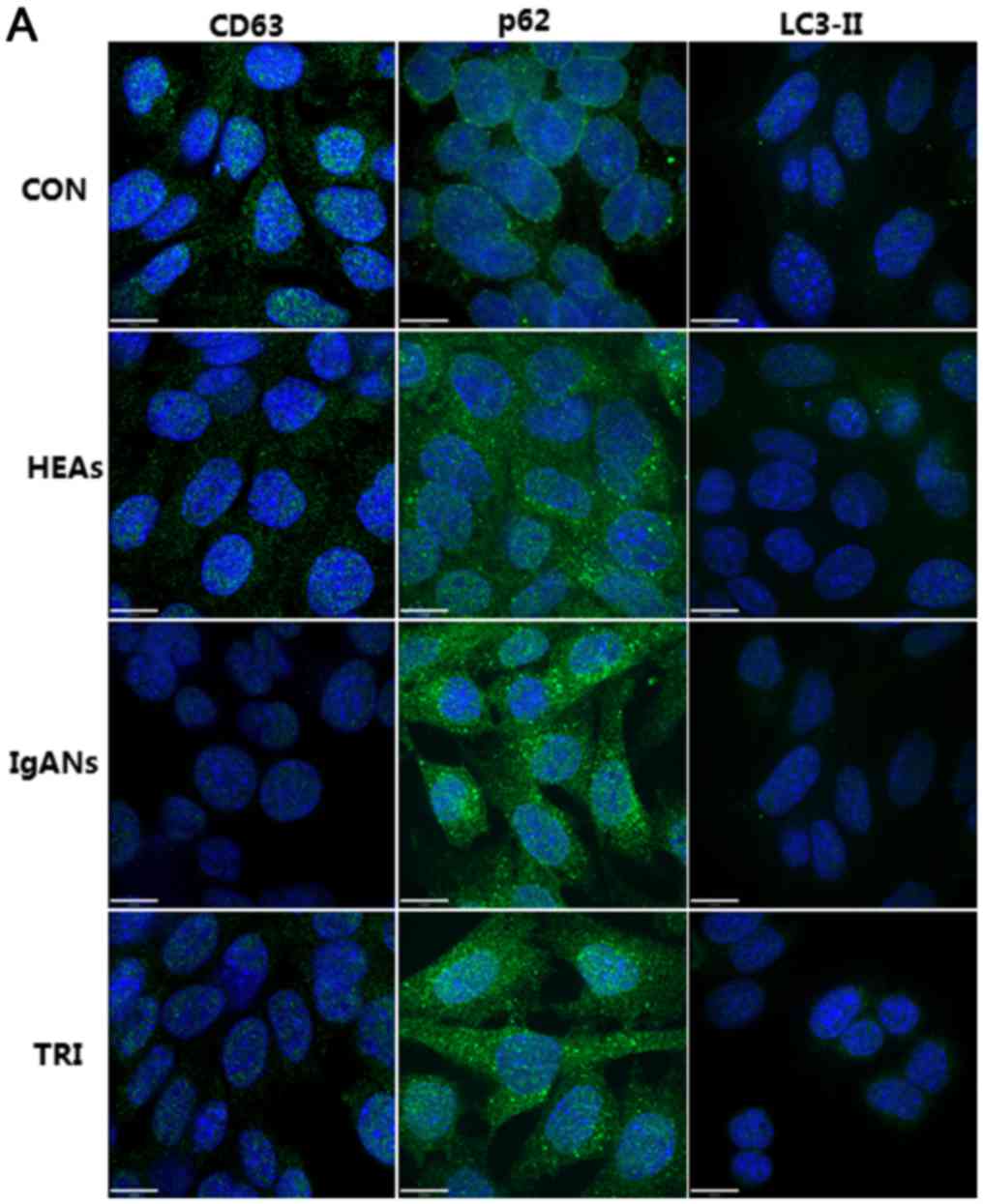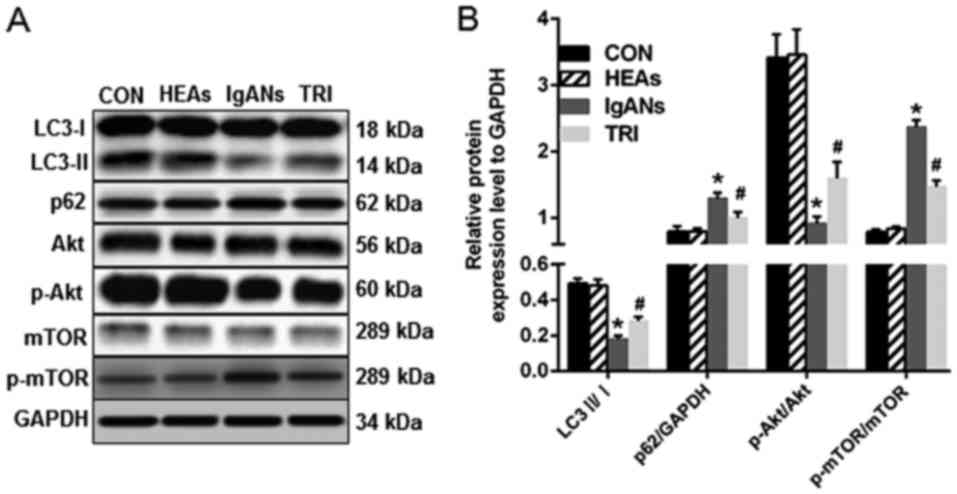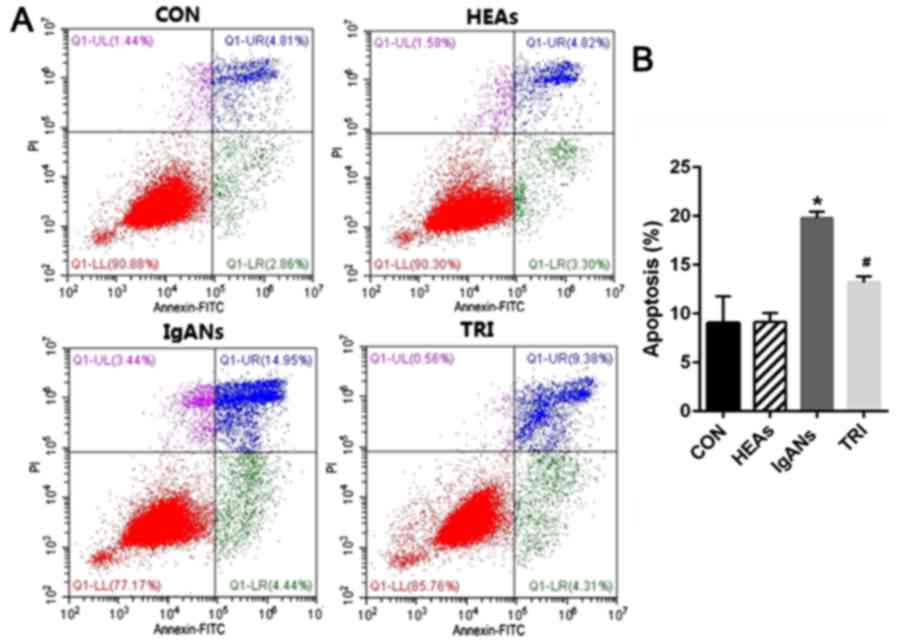|
1
|
Berger J and Hinglais N: Intercapillary
deposits of IgA-IgG. J Urol Nephrol (Paris). 74:694–695. 1968.(In
French). PubMed/NCBI
|
|
2
|
Gharavi AG, Kiryluk K, Choi M, Li Y, Hou
P, Xie J, Sanna-Cherchi S, Men CJ, Julian BA, Wyatt RJ, et al:
Genome-wide association study identifies susceptibility loci for
IgA nephropathy. Nat Genet. 43:321–327. 2011. View Article : Google Scholar : PubMed/NCBI
|
|
3
|
Wang C, Tang Y, Peng H, Ye ZC, Chen ZJ, Yu
XQ and Lou TQ: Supernatant of cultured mesangial cells with IgA1
from IgA nephropathy induces apoptosis of podocyte. Chin J Nephrol.
24:387–391. 2008.
|
|
4
|
Wang C, Ye Z, Peng H, Tang H, Liu X, Chen
Z, Yu X and Lou T: Effect of aggregated immunoglobulin A1 from
immunoglobulin A nephropathy patients on nephrin expression in
podocytes. Nephrology (Carlton). 14:213–218. 2009. View Article : Google Scholar : PubMed/NCBI
|
|
5
|
Zhu L, Zhang Q, Shi S, Liu L, Lv J and
Zhang H: Synergistic effect of mesangial cell-induced CXCL1 and
TGF-β1 in promoting podocyte loss in IgA nephropathy. PLoS One.
8:e734252013. View Article : Google Scholar : PubMed/NCBI
|
|
6
|
Tewari R, Nada R, Rayat CS, Boruah D,
Dudeja P, Joshi K and Sakhuja V: Correlation of proteinuria with
podocyte foot process effacement in IgA nephropathy: An
ultrastructural study. Ultrastruct Pathol. 39:147–151. 2015.
View Article : Google Scholar : PubMed/NCBI
|
|
7
|
Shen P, Shen J, Li W and He L: Urinary
podocyte can be an indicator for the pathogenetic condition of
patients with IgA nephropathy. Clin Lab. 60:1709–1715. 2014.
View Article : Google Scholar : PubMed/NCBI
|
|
8
|
Yasuda-Yamahara M, Kume S, Tagawa A,
Maegawa H and Uzu T: Emerging role of podocyte autophagy in the
progression of diabetic nephropathy. Autophagy. 11:2385–2386. 2015.
View Article : Google Scholar : PubMed/NCBI
|
|
9
|
Hartleben B, Gödel M, Meyer-Schwesinger C,
Liu S, Ulrich T, Köbler S, Wiech T, Grahammer F, Arnold SJ,
Lindenmeyer MT, et al: Autophagy influences glomerular disease
susceptibility and maintains podocyte homeostasis in aging mice. J
Clin Invest. 120:1084–1096. 2010. View
Article : Google Scholar : PubMed/NCBI
|
|
10
|
Li XJ, Jiang ZZ and Zhang LY: Triptolide:
Progress on research in pharmacodynamics and toxicology. J
Ethnopharmacol. 155:67–79. 2014. View Article : Google Scholar : PubMed/NCBI
|
|
11
|
Liang S, Jin J, Lin B, Gong J, Li Y and He
Q: Rapamycin induces autophagy and reduces the apoptosis of
podocytes under a stimulated condition of immunoglobulin A
nephropathy. Kidney Blood Press Res. 42:177–187. 2017. View Article : Google Scholar : PubMed/NCBI
|
|
12
|
Dai Q, Liu J, Du YL, Hao X, Ying J, Tan Y,
He LQ, Wang WM and Chen N: Histone deacetylase inhibitors attenuate
P-aIgA1-induced cell proliferation and extracellular matrix
synthesis in human renal mesangial cells in vitro. Acta Pharmacol
Sin. 37:228–234. 2016. View Article : Google Scholar : PubMed/NCBI
|
|
13
|
Yang Q, Sun M, Chen Y, Lu Y, Ye Y, Song H,
Xu X, Shi S and Wang J: Triptolide protects podocytes from
TGF-β-induced injury by preventing miR-30 downregulation. Am J
Transl Res. 9:5150–5159. 2017.PubMed/NCBI
|
|
14
|
Liu ZH: Nephrology in China. Nat Rev
Nephrol. 9:523–528. 2013. View Article : Google Scholar : PubMed/NCBI
|
|
15
|
Wyatt RJ and Julian BA: IgA nephropathy. N
Engl J Med. 368:2402–2414. 2013. View Article : Google Scholar : PubMed/NCBI
|
|
16
|
Lin M, Du L, Brandtzaeg P and
Pan-Hammarström Q: IgA subclass switch recombination in human
mucosal and systemic immune compartments. Mucosal Immunol.
7:511–520. 2014. View Article : Google Scholar : PubMed/NCBI
|
|
17
|
Graziose R, Lila MA and Raskin I: Merging
traditional Chinese medicine with modern drug discovery
technologies to find novel drugs and functional foods. Curr Drug
Discov Technol. 7:2–12. 2010. View Article : Google Scholar : PubMed/NCBI
|
|
18
|
Liu Q: Triptolide and its expanding
multiple pharmacological functions. Int Immunopharmacol.
11:377–383. 2011. View Article : Google Scholar : PubMed/NCBI
|
|
19
|
He L, Peng X, Liu G, Tang C, Liu H, Liu F,
Zhou H and Peng Y: Anti-inflammatory effects of triptolide on IgA
nephropathy in rats. Immunopharmacol Immunotoxicol. 37:421–427.
2015. View Article : Google Scholar : PubMed/NCBI
|
|
20
|
Zheng CX, Chen ZH, Zeng CH, Qin WS, Li LS
and Liu ZH: Triptolide protects podocytes from puromycin
aminonucleoside induced injury in vivo and in vitro. Kidney Int.
74:596–612. 2008. View Article : Google Scholar : PubMed/NCBI
|
|
21
|
Wang YG, Sun W and Zhen YJ: Preventive
effect of multi-glycoside of Tripterygium wilfordii Hook. f. on
proteinuria and mesangial injury in experimental mesangial
proliferative glomerulonephritis. Zhongguo Zhong Xi Yi Jie He Za
Zhi. 25:817–821. 2005.(In Chinese).
|
|
22
|
Ma R, Liu L, Liu X, Wang Y, Jiang W and Xu
L: Triptolide markedly attenuates albuminuria and podocyte injury
in an animal model of diabetic nephropathy. Exp Ther Med.
6:649–656. 2013. View Article : Google Scholar : PubMed/NCBI
|
|
23
|
Jiang CB, Wei MG, Tu Y, Zhu H, Li CQ, Jing
WM and Sun W: Triptolide attenuates podocyte injury by regulating
expression of miRNA-344b-3p and miRNA-30b-3p in rats with
adriamycin-induced nephropathy. Evid Based Complement Alternat Med.
2015:1078142015. View Article : Google Scholar : PubMed/NCBI
|
|
24
|
Sato S, Yanagihara T, Ghazizadeh M,
Ishizaki M, Adachi A, Sasaki Y, Igarashi T and Fukunaga Y:
Correlation of autophagy type in podocytes with histopathological
diagnosis of IgA nephropathy. Pathobiology. 76:221–226. 2009.
View Article : Google Scholar : PubMed/NCBI
|
|
25
|
Liang S, Jin J, Gong J, Lin B, Li Y and He
Q: How many podocyte autophagosomes are there in immunoglobulin A
nephropathy and idiopathic membranous nephropathy? Int Urol
Nephrol. 48:2109–2114. 2016. View Article : Google Scholar : PubMed/NCBI
|
|
26
|
Yang Y, Gao K, Hu Z, Li W, Davies H, Ling
S, Rudd JA and Fang M: Autophagy upregulation and apoptosis
downregulation in DAHP and triptolide treated cerebral ischemia.
Mediators Inflamm 2015. 1201982015.
|
|
27
|
Hu G, Gong X, Wang L, Liu M, Liu Y, Fu X,
Wang W, Zhang T and Wang X: Triptolide promotes the clearance of
α-synuclein by enhancing autophagy in neuronal cells. Mol
Neurobiol. 54:2361–2372. 2017. View Article : Google Scholar : PubMed/NCBI
|
|
28
|
Park JH, Kim KP, Ko JJ and Park KS:
PI3K/Akt/mTOR activation by suppression of ELK3 mediates
chemosensitivity of MDA-MB-231 cells to doxorubicin by inhibiting
autophagy. Biochem Biophys Res Commun. 477:277–282. 2016.
View Article : Google Scholar : PubMed/NCBI
|

















